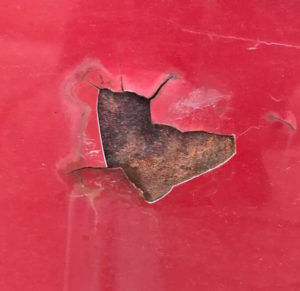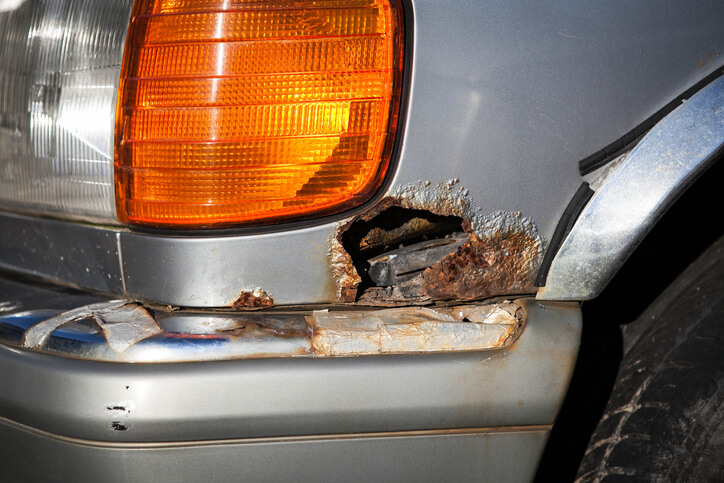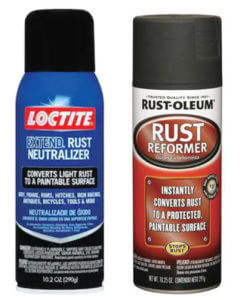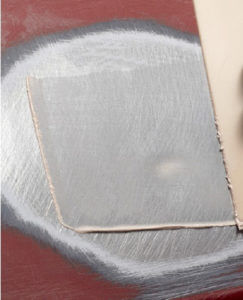Car Rust Repair
Car Rust Repair — How to
So you see rust on your car and want to fix it yourself. In most cases, car rust repair is a DIY project. But before you dive into the repair, you need to know how to prevent the rust from reoccurring after you’ve put in all that hard work.
Identify the type of car rust
Surface rust
Surface rust occurs when the protective paint and primer layers have been compromised by chips. Surface rust is the kind that has not penetrated deep into the metal or rusted all the way through. It’s the easiest to remove and the easiest to repair. In most cases the car rust repair process involves sanding, priming and painting without the need for body filler or patching.
Scale rust
Scale rust is the next most serious type because

Pitted scale rust
the rust has penetrated into the steel. It’s far more common than surface rust because by the time you notice the rust, it has already pitted the steel. The rust must be removed, neutralized and the pits filled with body filler before priming and painting.
Penetrating rust
At this stage the rust has eaten holes into the steel. This type of rust is the hardest to repair and if the repair isn’t done right, the rust will just come back.

detail of rusty car
Surface car rust repair steps
Sand off the rust using 80-grit sandpaper. Feather at least 1” into the surrounding paint. Once the surface rust is off, switch to 120-grit sandpaper and smooth out the sandpaper scratches. Then switch to 220-grit sandpaper. As long as you’ve removed all traces of rust and there is no pitting, you can proceed to clean, prime and paint the area.
Wipe the entire area with wax remover before spraying. If there’s any wax left on the painted surface, the paint won’t stick. Next, spray the area with a high-quality automotive primer containing zinc. Allow the primer to dry. Then lightly sand the primer with 400-grit wet/dry sandpaper. Wash with soap and water and allow to dry. Then spray the area with automotive touch-up paint and automotive clear coat following the paint manufacturer’s instructions.
Scale car rust repair steps
Just like surface rust, begin the repair by sanding with 80-grit sandpaper. Feather at least 1” into the surrounding paint. Wash the entire  area with wax remover before proceeding to the next step. To neutralize the rust in the pinholes, treat the area with a spray rust neutralizer like Loctite rust neutralizer or Rustoleum Rust Converter. Allow the converter to dry and then sand the area again with 90-grit sandpaper.
area with wax remover before proceeding to the next step. To neutralize the rust in the pinholes, treat the area with a spray rust neutralizer like Loctite rust neutralizer or Rustoleum Rust Converter. Allow the converter to dry and then sand the area again with 90-grit sandpaper.
Clean the area again with wax remover. Then mix a small batch of body filler and use a spreader to force the filler into the pits and scratches. This is called a “tight coat.” Lightly sand the area with 320-grit sandpaper and feather into the surrounding paint. If the surface is level and you can’t feel the pits, proceed to prime and paint.

Filling scratches and pits with body filler
Fix Penetrating Car Rust
If the rust has perforated all the way through the metal, you’ll have to cut out the rusted area and fill the area with new metal or body filler backed by stainless steel or fiberglass backing. Start by cutting out the rusted area. Use a tin snips, air nibbler or rotary tool with a cutting wheel. The tin snips and air nibbler work best because they don’t overheat the metal like a cutting wheel. See the video below for tips on how to use a nibbler.
Once you’ve cut out the rusted metal, use a panel crimper or flange tool to bend a ledge into the area you just cut out. A body shop would weld in a patch along the flange, but you’ll use the ledge to install your backer. See this video on how to make a flange
Next, cut a patch to fit the shape of the cut-out area using a stainless steel screen. Pop-rivet the screen to the flange. Grind the pop-rivet heads down so they’re level with the edge of the sheet metal. Then fill the area with a light coat of body filler. Never apply more than ¼” depth of filler at one time. Several shallow applications are better and stronger than one thick application of filler. Shape the filler to the contour of the sheet metal until the patch is completely filled. Then perform the final shape using 80-grit sandpaper. Once you have the rough shape, switch to 220-grit and then 320-grit sandpaper.
Clean the surface with wax remover and fill any small holes with cream filler. Then sand the entire area with 400-grit wet/dry sandpaper. Prime, sand, and paint.
©, 2020 Rick Muscoplat
Posted on by Rick Muscoplat